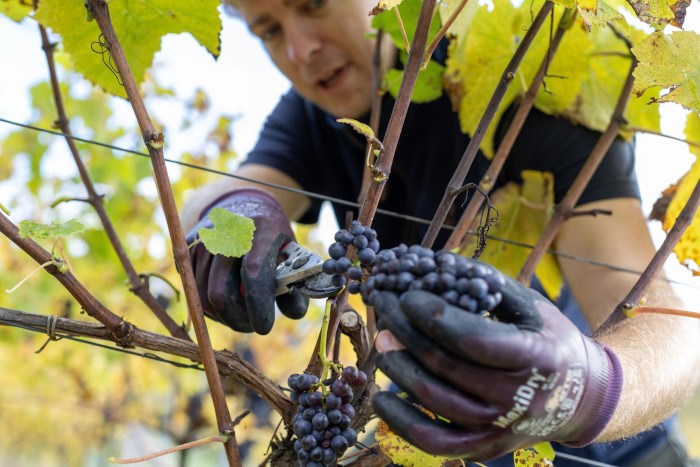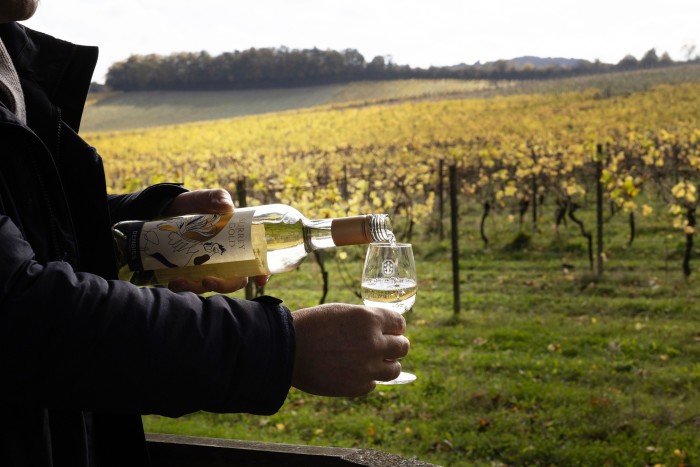
Planted in the chalky soil of the undulating Surrey Hills, England’s largest vineyard Denbies is one of the wine sector’s biggest success stories, producing 1mn bottles and drawing 400,000 visitors a year.
But chief executive and owner Christopher White said ministers should support the British wine industry by creating a level playing field with European producers, whose governments, unlike the UK’s, impose minimal or zero excise duty on homegrown vintages.
The only way for producers to make a return after paying heavy fees to distributors and duty to HM Revenue & Customs was to sell to visitors to their vineyards at the “cellar door”, White said, and cut out the middle man.
“If we were just to rely on external sales, I’m not sure I could say we would be here today,” said White, noting that his 265-acre estate aimed to make 50 per cent of sales direct to the customer. “The margin for the grower is tiny, if anything at all, and what that doesn’t allow for is good or bad harvests.”
English winemakers are urging chancellor Rachel Reeves to introduce tax breaks in next week’s Budget for domestically produced wine as the fast-growing sector struggles with low returns, an increasingly volatile climate and intense competition.

The UK now has 1,030 vineyards, more than double the number of a decade ago, according to trade body WineGB. Excitement about the fast growth of the industry has prompted more farmers to diversify into growing vines, and inspired wealthy wine enthusiasts with spare cash to set up estates.
A bumper harvest produced 21.6mn bottles of wine across Britain last year, a 77 per cent jump compared with 2022. Sales rose 10 per cent in the same period. But this year winemakers in England suffered the second-worst harvest on record, official data shows, with persistent wet weather and disease battering vines.
Shares in Chapel Down plunged on Friday after England’s largest wine brand downgraded its sales guidance on the back of the weak harvest, and withdrew plans for a sale following a strategic review.
Winemakers said the excise duty levied on wine by HMRC was putting them at a disadvantage to European producers, and trade groups have called for an extension of small producer relief to support the sector’s growth.
The tax break, which drove the craft brewing boom in the 2010s, allows businesses producing drinks that are measured at less than 8.5 per cent alcohol by volume (ABV) to pay a lower rate of duty.
In August 2023, the then Conservative government implemented a new alcohol duty regime, under which drinks with stronger alcohol content are taxed at a higher rate. An easement introduced for wine from 11.5 per cent to 14.5 per cent ABV will end on February 1, and wine importers have warned that the change will push prices even higher for consumers.
Victoria Vyvyan, president of the Country Land and Business Association, which speaks for landowners and rural businesses, said the taxes meant producers were “often paying more in duty than they take home in profit”. “Cut the tax . . . and we’ll see British vineyards flourish,” she added.

The UK is one of the few countries in Europe that applies excise duty to domestic wines. Ten EU member states, including Spain, Italy and Portugal, impose no such levy on homegrown still and sparkling wine. Most of the rest charge under €1 per bottle, according to analysis by WineGB.
France — which produced almost one-third of all wine in Europe last year, according to the International Organisation of Vine and Wine — charged €0.03 per bottle of still wine and €0.07 per bottle of sparkling wine in 2022.
The current UK system applies a flat duty rate of £2.67 for wines in the 11.5-14.5 per cent ABV bracket.
Industry bodies in Britain argue lower duty will help spur sales, which in turn, they say, will lead to an increase in collected excise duty. The Office for Budget Responsibility, the fiscal watchdog, estimates that HMRC raised £12.7bn in the 2023-24 tax year.
“Duty rates are acting as a lag to the level of growth we can have and a cut to overall duty, or reliefs, would provide considerable reassurance for our businesses and enable them to invest and grow,” said WineGB chief executive Nicola Bates.
Trade groups have proposed a “cellar door relief” that would allow producers to claim the tax break on sales made at the actual wineries, saying the change would also boost wine tourism. In a pre-Budget submission to the Treasury, WineGB proposed that such a scheme cover 13,500 bottles per vineyard.
The Treasury said it was “supporting businesses, including UK winemakers through pledges to make the business rates system fairer, cap corporation tax at 25 per cent and to publish a corporate tax roadmap”.

Smaller producers, who constitute the majority of UK wine businesses, are especially reliant on cellar-door sales because they cannot achieve the scale of larger rivals that sell through supermarkets and in pub and restaurant chains.
Peter Townsend, head of wine at Dunesforde vineyard in West Yorkshire, one of Britain’s most northerly vineyards, said he paid between £2 and £3 of duty per bottle of wine, which is passed on to customers.
“There is a facility in place already that could be expanded to include wines,” said Townsend. “Its designed for a time when England wasn’t making wine. If we put small producer relief in place today, it would have been put at 15 per cent.”
Family-run Dunesforde, which planted its first vines in 2016 and made its first wine three years later, produces between 10,000 and 15,000 bottles a year from its four acres. About 75 per cent of output is sold at the cellar door, with the rest bought by restaurants at break-even prices, largely as a marketing strategy, Townsend said.
“The vast majority [of vineyards] won’t sustain in the environment at the moment,” he said. “For pretty much everyone it’s a passion project, not a get-rich-quick scheme.”